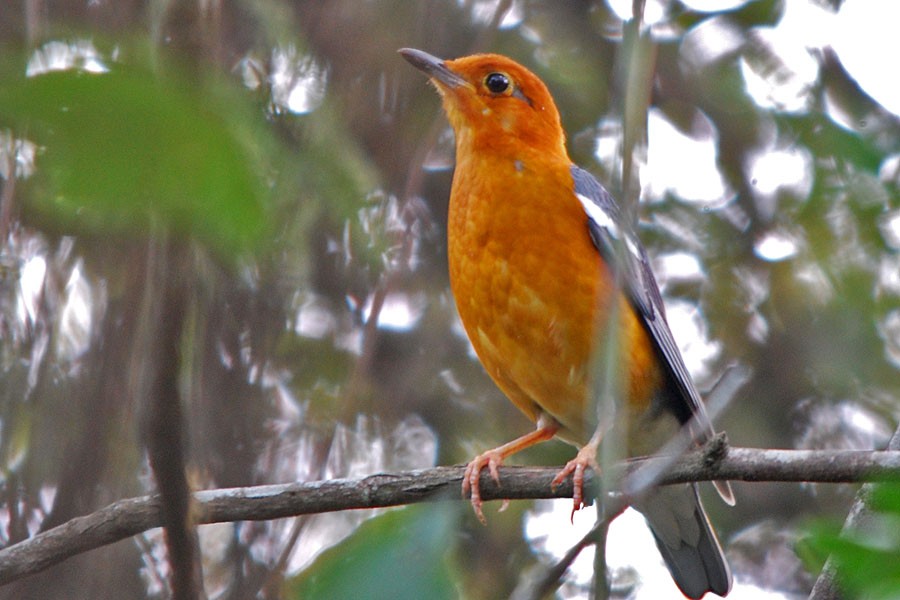Orange-headed Thrush
A species of Ground Thrushes and Allies Scientific name : Geokichla citrina Genus : Ground Thrushes and Allies
Orange-headed Thrush, A species of Ground Thrushes and Allies
Botanical name: Geokichla citrina
Genus: Ground Thrushes and Allies
Content
Description General Info
 Photo By GnanaskandanK , used under CC-BY-SA-3.0 /Cropped and compressed from original
Photo By GnanaskandanK , used under CC-BY-SA-3.0 /Cropped and compressed from original Description
The orange-headed thrush is 205–235 milliimetres (8.1–9.25 in) long and weighs 47–60 grammes (1.7–2.1 oz). The adult male of the nominate subspecies of this small thrush has an entirely orange head and underparts, uniformly grey upperparts and wings, and white median and undertail coverts. It has a slate-coloured bill and the legs and feet have brown fronts and pink or yellowish rears. The female resembles the male but has browner or more olive upperparts and warm brown wings, but some old females are almost identical to the male. The juvenile is dull brown with buff streaks on its back, and a rufous tone to the head and face; it has grey wings. The bill is brownish horn, and the legs and feet are brown. This species' orange and grey plumage is very distinctive, and it is unlikely to be confused with any other species. Differences between the subspecies, as described above, can be quite striking, as with the strong head pattern on Z. c. cyanotus, but may be less obvious variations in plumage tone, or whether there is white on the folded wing. As with other Zoothera thrushes, all forms of this species shows a distinctive underwing pattern, with a strong white band. 
Size
23 cm
Colors
Gray
Blue
Orange
Life Expectancy
20 years
Nest Placement
Tree
Feeding Habits
Orange-headed Thrush, primarily a ground forager, consumes insects, larvae, spiders, other invertebrates, and fruit, with a preference for figs in Malaysia. Active at dawn and dusk, orange-headed Thrush searches leaf litter in thick underbrush.
Habitat
Orange-headed Thrush primarily inhabits moist broadleaved evergreen forests with medium-density underbrush. This bird can also be found in bamboo forests, secondary growth areas, plantations, and shady village groves. It typically resides near streams or in lower-elevation ravines, with an altitude range extending up to 2300 meters in the Himalayas, and prefers areas with running water. For the subspecies, habitats include overgrown ravines, thick montane forests, and at elevations from 900 to 1800 meters in Borneo. Some populations are migratory, occupying similar habitats at lower altitudes during winter.
Dite type
Frugivorous
General Info
Feeding Habits
Bird food type

Fruit
Behavior
The orange-headed thrush is a shy, secretive bird usually occurring alone or in pairs, but is comparatively more easily seen than many other Zoothera thrushes, and several birds may congregate outside the breeding season at a good food source. It has a swift, silent flight, but when disturbed will often sit motionless until the threat has passed. 
Distribution Area
The orange-headed thrush breeds in much of the Indian Subcontinent, including Bangladesh, India and Sri Lanka, and through Southeast Asia to Java. Its habitat is moist broadleaved evergreen woodlands, with a medium-density undergrowth of bushes and ferns, but it also utilises bamboo forests for secondary growth. Z. c. cyanotus also occurs in large gardens and orchards. This species is often found in damp areas, near streams or in shady ravines. It occurs between 250–1830 metres (825– 6040 ft) in the Himalayas and up to about 1500 metres (5000 ft) in Malaysia, Thailand and Java. Z. c. aurata is resident between 1000–1630 metres (3300–5400 ft) on Mt Kinabalu and Mt Trus Madi, northern Borneo. Some of the subspecies are completely or partially migratory; their wintering habitat is similar to the breeding forests, but more likely to be at lower altitudes. 
Species Status
Not globally threatened.